Motorsports
Leclerc, Sainz at a loss over lack of wet-weather Ferrari pace in Brazilian GP
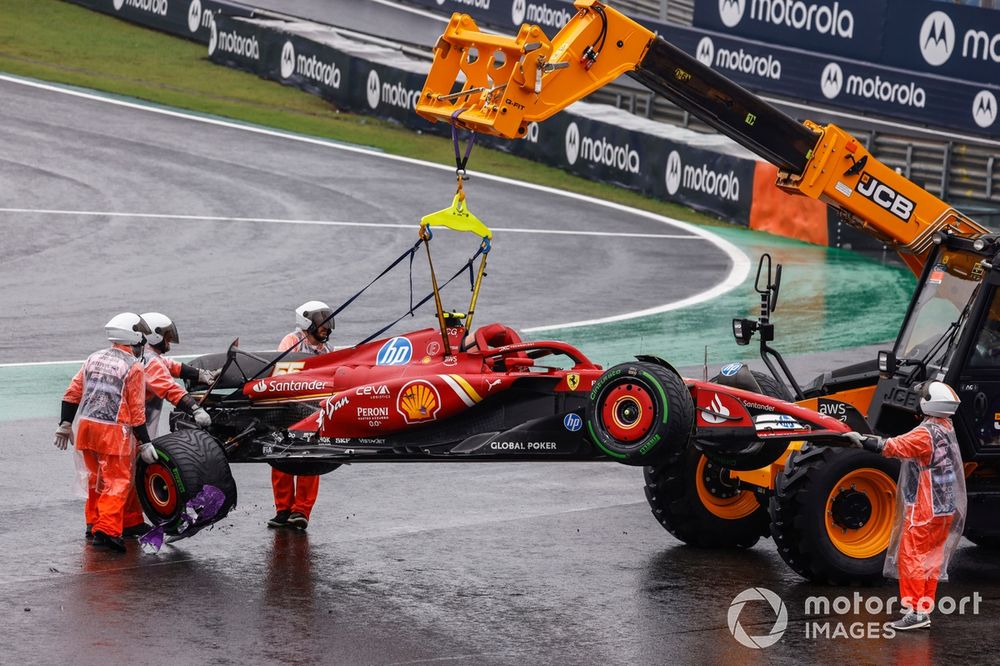
Ferrari drivers Charles Leclerc and Carlos Sainz admit they were at a loss to explain why they could not match the pace of their rivals at the Brazilian Grand Prix.
Leclerc came home fifth, improving one place on his qualifying position, but was over half a minute behind race winner Max Verstappen, who cut his way through the field to take victory from 17th.
While Leclerc’s weekend was forgettable, Sainz’s was miserable as he crashed out in both qualifying and the race before being hit with a stewards’ reprimand for dangerous driving as he tried to drive off in his stricken Ferrari despite marshals already being on the scene.
The outcome in Brazil was as gloomy as the weekend weather, especially considering Sainz’s victory in Mexico and Leclerc’s success in Austin at the other races during F1’s latest triple-header.
“I’ve always been a very strong driver in the wet but for some reason, ever since I’ve tried this car in the wet, I’ve never had a good feeling with it,” explained Sainz.
“I don’t know if we just don’t put energy into the tyres, we run it too stiff in the medium to high speed, or what it is. It is clear that it is very difficult and unpredictable to drive.
Marshals remove the damaged car of Carlos Sainz, Ferrari SF-24, after a crash
Photo by: Andrew Ferraro / Motorsport Images

“I’m pleased that Charles managed to bring it home in P5. I heard he was also struggling, so a bit of a nightmare the whole race, but hopefully, some dry races coming up and we will try to go for it.”
Leclerc was prepared to shoulder some of the blame for the poor performance but was pleased that his fifth place keeps Ferrari second in the constructors’ standings, where it sits 36 points behind leaders McLaren.
“Really not at all,” the Monegasque replied when asked if the car did not like the wet or intermediate tyre during the race.
“I think I’m partly to blame because obviously we decide the set-ups with together with the team. I wanted to go in a direction, however it was the wrong one, for sure. The pace was just not there, whether it was in qualifying, where I think in qualifying, we actually weren’t too bad.
“With the new tyres, low fuel, you can extract more out of the car, but in the race, we were nowhere – and more than being nowhere, it was extremely difficult to drive, extremely difficult to not do any mistakes.
“At the end, looking at all this, the only thing we could be a little bit satisfied of is being in front of the two McLarens and to only lose four points in the constructors is big damage limitation on the weekend where they seem to be so strong.”
Lando Norris, McLaren MCL38, Charles Leclerc, Ferrari SF-24, Oscar Piastri, McLaren MCL38
Photo by: Zak Mauger / Motorsport Images

Ferrari has been in fine form of late and could still claim a first constructors’ crown since 2008 if they can reel in and pass McLaren in the closing weeks of the season – starting in Las Vegas later this month.
“We will be alive until the very end,” added Sainz. “Three weekends now coming up that are going to be important for the whole team and now we need to refocus, regroup and see how we can approach these last three races in the best possible way.”
Motorsports
How to set up a Formula 1 wind tunnel
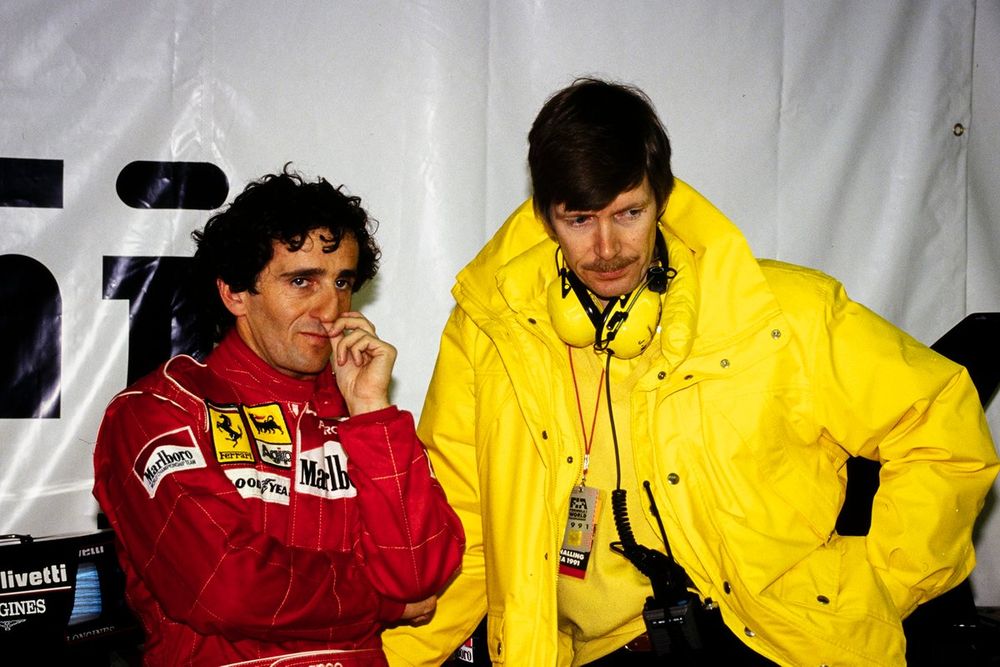
It was only a few years ago that some of Formula 1’s brightest minds were predicting a future where wind tunnels were no longer needed. Think of the wasted expense powering a giant fan in a massive, empty room filled with nothing but a 60% scale model of a car, and all the time spent poring through the data readouts.
It seemed that technological progress was reaching a cross-over point, one where computer simulations could do all of that and accurately – and effectively – predict flow patterns around a car.
And here we are, the year 2024 of the common era, and two F1 teams are in the process of either building or finalising brand-spanking-new wind tunnel designs. Aston Martin is in the commissioning phase of its new in-house facility, while Red Bull is aiming to have a new wind tunnel in operation by 2026. McLaren, for its part, had finished its own new build in 2023.
The anticipation for both incoming wind tunnels among the teams will be stratospheric. These are often held up as a significant influence on performance, one that can change the fortunes of a team and stall any hints of a decline. But, as ever, it’s not quite as simple as that – even after construction, there are months of work ahead before the wind tunnel is even remotely useable.
In those months, there will be significant challenges in getting the wind tunnels ship-shape. Aston Martin is already delving into those, while Red Bull will have to go through the entire rigmarole in about 12 months’ time when it moves out of its Bedford tunnel – which dates to the Cold War as part of an aeronautical research site.
These are the challenges we don’t hear about; the narrative always seems to lean towards the following phraseology: “Team X has a new wind tunnel, it’ll work off the bat and the car will be competitive”. Let’s set the record straight and explain how to set up a wind tunnel, and detail the work that Aston Martin and Red Bull have ahead.
Alain Prost, Ferrari, Jean-Claude Migeot
Photo by: Ercole Colombo

To do that, we’ve asked former F1 aerodynamicist Jean-Claude Migeot – formerly of Tyrrell and Ferrari, and the architect of F1’s high-nose era – to assist. Migeot has been heavily involved in the development of multiple wind tunnels over his post-F1 career, including the Aerolab and Fondtech facilities in Italy, so he’s the perfect person to help us untangle the key details.
“First of all, I don’t think you get benefits straight away,” Migeot begins. “You have to build confidence. A wind tunnel is not reality, it’s a laboratory. So, you have to trust it behaves like a laboratory, which means if you’re ever going to repeat something, it’s that the results are going to repeat perfectly.
“That’s the minimum required, and then [you build] confidence between the real thing and your simulation in the wind tunnel, and it takes some time to build that confidence. But it depends on the background of the people using it.”
In this, he cites the example of McLaren switching to its new wind tunnel – ending its reliance on the Toyota facilities in Cologne – and the perceived impact that this had on the Woking team. This coincided with the team’s upward mobility in 2023, as upgrades took the team from one floundering in the mid-pack to one fighting at the sharp end of the grid. Building the wind tunnel is only the first step.
Once the building has been completed, with all monitoring equipment installed, the tunnel then needs to go through what’s known as ‘commissioning’, and that’s before the work can even start with a wind tunnel calibration model. It’s a lengthy process, and one that Aston Martin is currently mired within as it hopes to get its tunnel working in time for the 2025 season.
“Step zero is commissioning,” Migeot explains. “This is where you have to check what has been sold to you is effectively achieved. You know, the air distribution, the turbulence, the temperature control, which is hugely important.
“You have to run the tunnel in all conditions and first check your builder has done a good job, then run all the electronics for the control [units]. It’s a huge work for a group of people and is taking at least one month. And then if that’s okay – because if that’s not okay, you are fixing something which is not hours, but days and weeks of changes – then you start to work with the model.”
Zak Brown, Lando Norris and Andrea Stella in the new wind tunnel at the McLaren Technology Centre
Photo by: McLaren

Explaining commissioning and correlation
Formula 1’s current ruleset is now into its third year, and the increased competitiveness of the 2024 field has demonstrated the level of convergence that is starting to be achieved with steady regulations. Teams are having to dig deeper to find lucrative opportunities to improve, but this is leading a number of teams to encounter correlation issues between the wind tunnel and their on-track findings.
For example, a new floor tested in the wind tunnel might churn out data that suggests it would be an upgrade worthy of entering the production phase for a future race. Once ready, the team tries it over a race weekend – but it either fails to offer the promised downforce gains or, more alarmingly, creates instability in the car.
There are a few notable examples of this happening over 2024. Ferrari went through a mid-season phase of floor iterations that progressively worsened high-speed bouncing through corners, while Aston Martin’s Imola upgrade made the car much harder for the drivers to handle. RB and Mercedes have both rolled back on floor upgrades, and Red Bull’s updates mid-season took a long time to untangle after introducing a variety of balance issues.
The catch-all explanation is that it’s a correlation problem and, at surface level, this is correct. Some of that is down to how a wind tunnel is calibrated, and perhaps there are losses somewhere in the tunnel that make it hard to achieve the right figure. Take Renault’s 2007 decline, for example; the then-reigning champion team appeared to suffer with its switch from Michelin to Bridgestone tyres due to the change in tyre profile.
Migeot explains that a tunnel doesn’t have to be perfectly calibrated to what is experienced on track, but the difference between the tunnel and real-world readings must be consistent.
“The tunnel will not give you the truth. It will give you something which, in the best scenario, is consistent with reality. If you have a quite fixed difference between reality and the tunnel, that’s fine; it can’t be identical. If you’re confident that, when you improve in the tunnel, you know it’s going to improve on the track, you’re saving a huge amount of time.
Sergio Perez, Red Bull Racing RB20
Photo by: Glenn Dunbar / Motorsport Images

“I hear this doesn’t work very much like that for many, the upgrades are brought to the track and then they return to the old configuration quite often these days. So I think a lot of teams are in correlation problems.”
So, can you ever achieve perfect correlation? “It’s endless, it’s a quest you never finish,” Migeot states. “You’re in a happy situation when you have confidence, but the situation can change quickly, and it would be radically changed by these rules of two years ago with a completely new floor.
“There’s many imperfections, like in the rubber tyres (on the model), maybe you don’t have the right tyre profile under yaw, there are many compromises and there’s maybe a hundred differences which you cannot have in the tunnel. You try your best and, if these things are kept to a very small influence, you’re okay.
“Then you are in the case of a fixed error, and you can make your development and improvements. But if suddenly one of these things becomes influential on the results, and you are again in correlation work. For example, a change of tyre dimension is not very often these days, but even the rubber state between new and used can make a difference on the track.
“All these things you have to collect, and it takes time. So it’s an endless subject. I think you have people on that all the time, measuring what’s happened on the track. If it’s only in some occasions you don’t correlate, it doesn’t stop you. But when you see a car which is on the front row on one race, and on the third or fourth row on the next race, then you have a problem.”
Motorsports
Pulling heads Formula E all-female test at Jarama
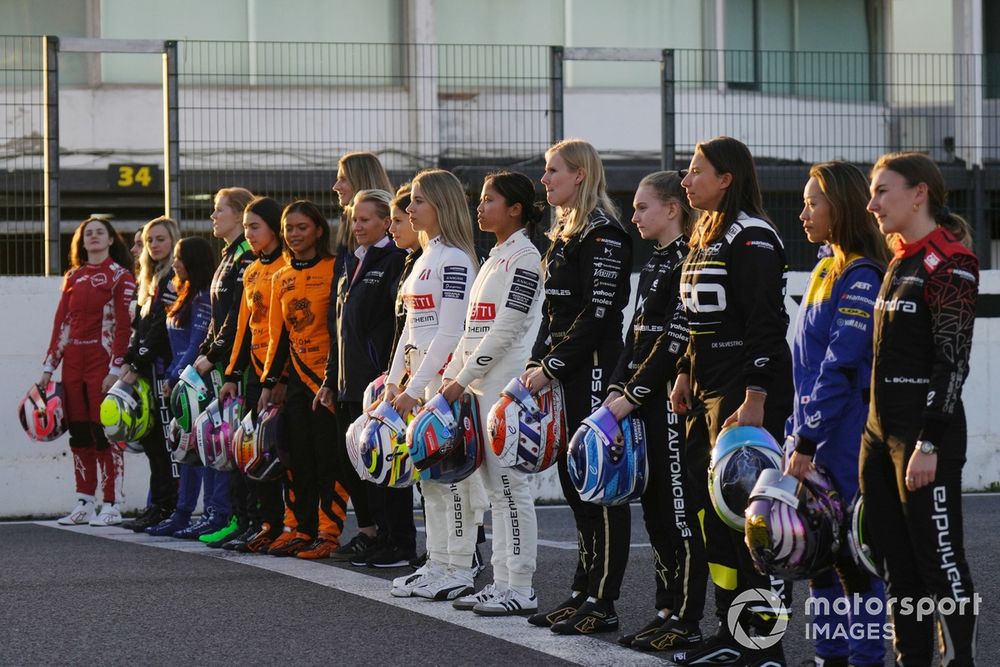
F1 Academy points leader Abbi Pulling finished fastest in the all-female Formula E test at the Jarama circuit on Friday.
The all-electric championship held a test exclusively for female drivers with all 11 Formula E teams required to field at least one driver, as 18 in total sampled the new Gen3 Evo machines.
Pulling, who can clinch the F1 Academy title at the next round in Qatar which would give her a fully-funded drive in the UK’s GB3 Championship next season, posted a 1m30.889s inside the final 60 minutes of the three-hour session.
The outing was her first time in a Formula E car, and after just one session her best lap left her just 4.5 seconds behind the quickest time from the four-day pre-season test, which was set by Jaguar’s Mitch Evans on Friday morning.
Three-time W Series champion Jamie Chadwick finished second, her final effort leaving her 0.320s behind Pulling.
The 26-year-old Briton, who also completed the most laps during the session with 39, previously tested Formula E machinery with Jaguar during the 2020 rookie test and will conduct the same test next season.
The female drivers
Photo by: Malcolm Griffiths / Motorsport Images

McLaren’s Bianca Bustamante became the first driver to dip below the 1m32s barrier during the second hour, and the F1 Academy driver finished the session third, 0.826s behind Pulling.
Miki Koyama also improved with her final effort to move into fourth for Lola, from Sauber Academy driver Lena Buhler (Mahindra) as Beitske Visser completed the top six for DS Penske.
Running in the final hour was curtailed after F1 Academy driver Jessica Edgar found the barriers in Jean-Eric Vergne’s DS Penske at Turn 3, which brought out a red flag as the car was recovered to the pits.
Simona de Silvestro returned to Formula E action having competed in 12 races between 2014-2016 during the Gen1 era with Andretti.
The Swiss-Italian, who has been a reserve driver for Porsche in Formula E, was driving for customer team Kiro but only completed six laps due to technical problems.
Jaguar’s second driver, Lilou Wadoux was the only driver unable to complete a lap at all as problems with her seat meant she was unable to take to the circuit.
| Cla | Driver | Team | Time | Delay | Laps |
| 1 | Abbi Pulling | Nissan | 1’30.889 | 39 | |
| 2 | Jamie Chadwick | Jaguar | 1’31.209 | 0.320 | 40 |
| 3 | B.Bustamante | Nissan | 1’31.715 | 0.826 | 39 |
| 4 | Miki Koyama | Lola | 1’31.731 | 0.842 | 31 |
| 5 | Lena Buehler | Mahindra | 1’31.907 | 1.018 | 36 |
| 6 | Beitske Visser | DS | 1’32.221 | 1.332 | 39 |
| 7 | Ella Lloyd | Nissan | 1’32.374 | 1.485 | 39 |
| 8 | Marta Garcia | Porsche | 1’32.624 | 1.735 | 36 |
| 9 | Carrie Schreiner | Maserati | 1’32.626 | 1.737 | 38 |
| 10 | Tatiana Calderon | Maserati | 1’32.815 | 1.926 | 37 |
| 11 | Jessica Edgar | DS | 1’33.155 | 2.266 | 36 |
| 12 | Alice Powell | Jaguar | 1’33.164 | 2.275 | 29 |
| 13 | Nerea Martí | Porsche | 1’33.805 | 2.916 | 37 |
| 14 | Gabriela Jílkov | Porsche | 1’34.556 | 3.667 | 36 |
| 15 | Chloe Chambers | Porsche | 1’35.130 | 4.241 | 39 |
| 16 | Alisha Palmowski | Jaguar | 1’35.145 | 4.256 | 24 |
| 17 | S.de Silvestro | Porsche | 1’35.499 | 4.610 | 9 |
| 18 | Lilou Wadoux | Jaguar | – | – | 9 |
Motorsports
Wolff reveals tip-off from Sainz Sr over Hamilton’s Ferrari F1 move
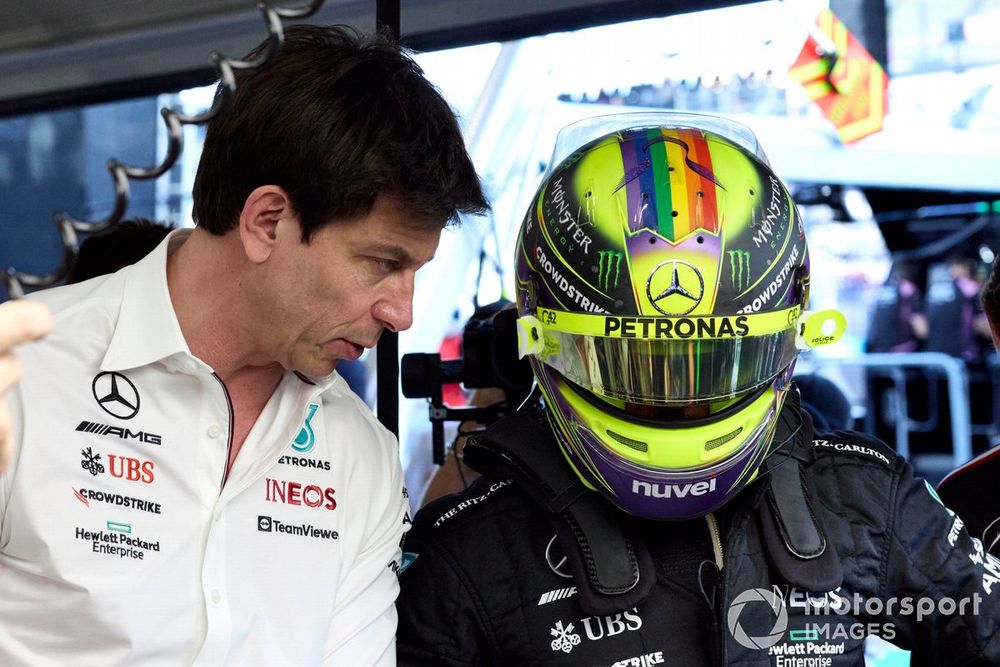
Mercedes boss Toto Wolff has opened up on details surrounding Lewis Hamilton’s shock move to Ferrari – and how he got an early tip-off from Carlos Sainz Sr.
Hamilton told Wolff during a visit to his house at the end of January that he would be activating an exit clause in his Mercedes contract and joining Ferrari for the 2025 season.
But while Hamilton’s announcement was the first official confirmation that Wolff had of his driver’s departure, he has now spoken at length about how he had been alerted to the prospect for a little while.
Speaking to the High Performance podcast, Wolff said that an initial call from Sainz Sr., father of the Ferrari driver Carlos that Hamilton is replacing, had been where he first got word that something was in the offing.
“So I heard the bells ringing two weeks before,” said Wolff. “Yeah, the old man Sainz called me and said, this is what’s happening.
“And then there were a few drivers’ dads rang me up that didn’t before. So I thought, Okay…there’s something going on there.
“And then I sent a text to [Ferrari boss] Fred Vasseur saying: ‘You’re taking our driver?’ Didn’t get any response. Very unusual for Fred. He’s a good friend. So yeah, I saw it coming.”
With his suspicion about the intention of Hamilton’s visit to his house, Wolff also revealed that he threw a curveball into their chat by first telling the seven-time champion about Mercedes having signed former Ferrari chief designer Simone Resta.

Toto Wolff, Team Principal and CEO, Mercedes-AMG, with Lewis Hamilton, Mercedes-AMG
Photo by: Steve Etherington / Motorsport Images
“When Lewis arrived in the house, like he did so many years before, we had a bit of a small talk, like we always do about the Christmas holidays and all of that,” explained Wolff.
“Then I said, “Well, we’re recruiting from Ferrari now. We got this guy.” And Lewis was, “Oh, there’s something I need to tell you.” And yeah, when he said that, that initial moment was a little bit of… so this is really happening?”
When news of Hamilton’s Ferrari decision was made public, it became one of the biggest shock news events of recent F1 history.
But Wolff said that he was able to deal with the situation in quite a calm manner.
“Well, I had much worse in my life, happening, like real drama and trauma,” he said. “This is not even moving the needle.”
He added: “It’s just a new situation. It has risks and opportunities, risks in the sense of how do I inform the sponsors as quickly as possible? Because it was leaking… And on the other side, what are we doing about next year?”
Wolff also made it clear that there was no temptation from his side to try to persuade Hamilton to change his mind.
“I think if someone decides to go, then you need to let them go,” he said. “I had a chat with Pep Guardiola a long time ago, and he is a friend. I said, ‘What do you do if this and that player leaves?’ And he said, ‘What do you mean I do?’ I said, ‘Well, do you try to convince them to stay?’
“He said: ‘No, if somebody thinks he can play elsewhere better or earns more – you have just got to let them go.’ And it is something that I embrace in the same way here. Somebody wants to go – then let’s make it as good as possible for each of the parties.”
Motorsports
Live – WSK Final Cup: Round 1 – Lonato

Continue reading with advertising …
… or with a subscription
Visit motorsport.com as usual with advertising and tracking. You can revoke your consent at any time via the data protection page.1
Use motorsport.com without any advertising banners, personalized tracking and commercials for a small fee.
More information about advertising and tracking in our Data protection notice, the List of our partners and in Data protection information center.
Already a subscriber?
Log in here
Motorsports
“Bagnaia is in a team built to win, we are against the world”
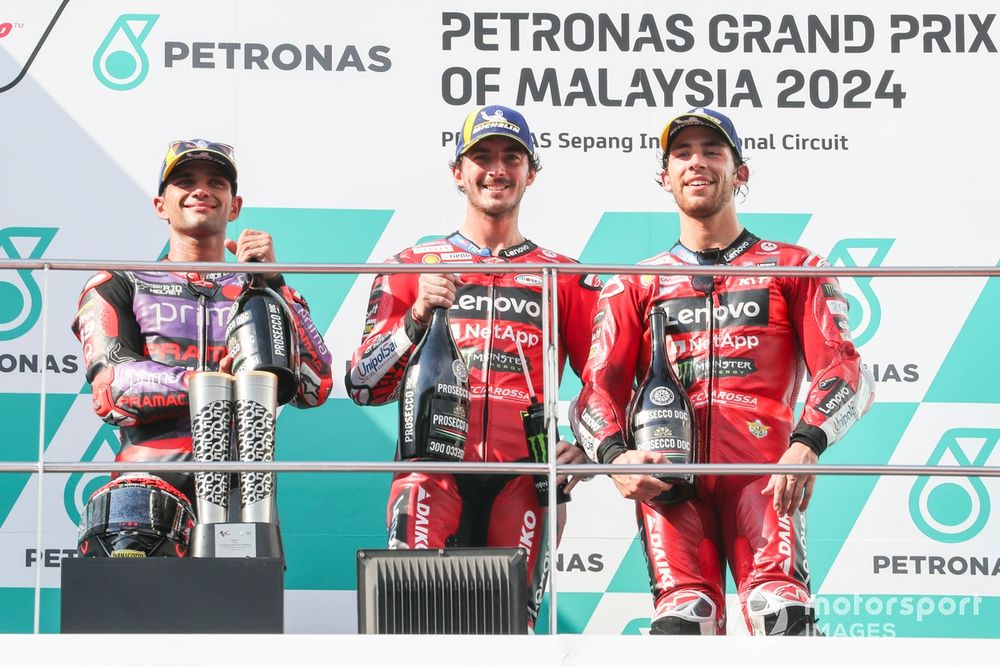
Jorge Martin feels he and Pramac have been fighting “against the world” in MotoGP this year, with his rival Francesco Bagnaia racing for a factory Ducati team that is “built to win”.
Martin is on the verge of winning the MotoGP world title having carved out a 24-point lead with just 37 on offer in next week’s Barcelona season finale.
Satellite teams have traditionally been at a massive disadvantage with respect to factory squads in the past, but Ducati has overhauled the way bike manufacturers compete in MotoGP in the last few years by forging a closer relationship with teams it supplies bikes to.
As part of its new methodology, Martin is contracted directly to Ducati and rides the same specification of GP24 as Bagnaia and Enea Bastianini in the factory team, thus offering him parity of equipment.
However, while the lines between satellite and factory teams have become blurred in recent years, Pramac remains an independent outfit and doesn’t have the same resources as that of a manufacturer.
It’s why the significance of winning a title against a factory rider is not lost on Martin, who could wrap up the championship as early as the sprint race in Barcelona.
“He’s in a different moment, he’s been in MotoGP for six years, he’s in an official team, he has everything, his environment, ready to win,” said the Spaniard.
“I have a team of 12 people who fight alone against the world, and with that to achieve what we have achieved, seven sprint [wins], three victories and 30 podiums [15 in races and another 15 in sprints], I can’t ask for more.
“[The success] is not because of me, it’s because of my people, my environment, my team, all the people around me, I just want to achieve it for them, so that they can enjoy it, that’s what fills me [with joy] and excites me.”
Francesco Bagnaia, Ducati Team, Jorge Martin, Pramac Racing
Photo by: Gold and Goose / Motorsport Images

Bagnaia has established himself as one of the best riders of the generation after winning back-to-back titles in 2022 and ’23 with Ducati.
The Italian has put up a strong fight against Martin this year, winning 10 of the 19 grands prix so far and scoring six further victories in the sprints.
Martin stressed that winning the 2024 title would carry extra value just because he would have defeated an in-form – if error-prone – Bagnaia to the crown.
“It is a pride to reach this point of the season fighting for the championship,” he said. “It’s a pride to have a rival like Bagnaia, because this makes me better.
“That Pecco is at his highest level and being able to fight with him, to be able to push him to the limit, makes what we are both doing more valuable.
“I’ve won seven times this year, true, but it will be very difficult in the last grand prix to beat a Pecco in the form he is in now.
“We’ll see how the weekend develops, it will be in colder conditions, which usually suits me better. With a lot of heat it’s a perfect condition for Bagnaia. There will be more chances of failing in lower temperatures, but the risk will be the same for both of us.
“It’s always difficult to play for a title in the last event, anything can happen. But I arrive confident and believing that I can achieve it.”
Motorsports
F1 2026 rule tweaks will open door for “different concepts”
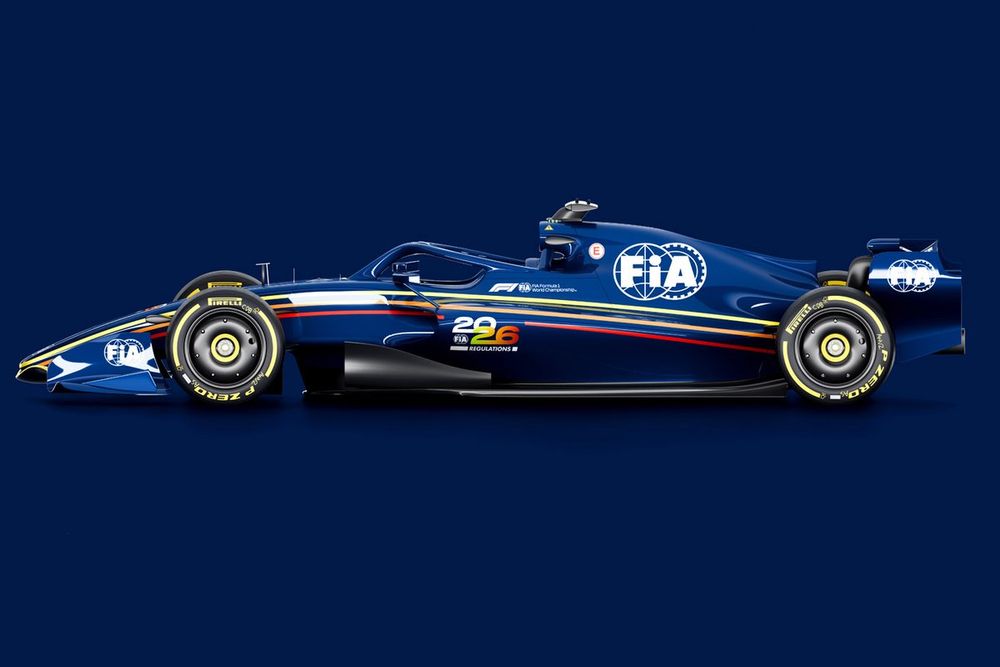
The recent changes to Formula 1’s technical regulations for 2026 will give teams more freedom to explore different design concepts, says Williams chief James Vowles.
Recently, the rules prescribing F1’s new car designs for 2026 have been tweaked following concerns that the new generation of cars would be too slow.
The new cars, which will be paired to overhauled engine regulations with a bigger reliance on electric energy, will have significantly less drag and wake turbulence to improve the racing, but the latest version of the rules has increased the amount of downforce they will generate to bring cornering speeds closer to current levels.
The FIA relaxed limitations around the front wing area and the front floor, with scope to add bargeboards, and the size of the diffuser has been increased compared to the draft that was presented to teams in June and received mixed reviews.
The changes were welcomed by the teams, not just because of the increase in performance but because there will now be more freedom for designers to explore different concepts. That could lead to cars that are visibly much more different across the grid compared to the current generation of ground-effect-based machinery, where teams soon converged on very similar concepts.
“We now have more freedom where you could see a different direction that you’re going in,” Vowles said. “So there’s more flow controlling devices in place, which lead to downforce, but differentiation between teams. What’s been really positive as well is there’s still some small areas of improvement around the diffuser.
“What’s great to see is teams in F1 working hand-in-hand in order to improve that, because every time you make a change like that, it has some consequences.
“I think what you’re going to see now is instead of all teams working in the same few millimetres, there’ll be some different concepts. I personally think that is good for the sport.”

F1 2026 FIA car renders
Photo by: FIA
Vowles’ McLaren counterpart Andrea Stella also felt giving engineers more freedom will lead to a bigger spread of designs.
“With the recent release of the car geometry, especially from an aerodynamic point of view, basically two main things have been achieved,” he explained. “One is a much higher downforce level, and the second one is more freedom. We welcome both.
“We welcome more freedom. I think this will give teams the possibility to just use their knowledge, use their methodologies. The knowledge that has been accrued over the years, even if with different regulations, is a way of creating some differentiation.
“So, we’ve always been advocating this kind of approach and we welcome the fact that there will be more freedom.”
-

 Science & Environment2 months ago
Science & Environment2 months agoHow to unsnarl a tangle of threads, according to physics
-

 Technology1 month ago
Technology1 month agoIs sharing your smartphone PIN part of a healthy relationship?
-

 Science & Environment2 months ago
Science & Environment2 months agoHyperelastic gel is one of the stretchiest materials known to science
-

 Science & Environment2 months ago
Science & Environment2 months ago‘Running of the bulls’ festival crowds move like charged particles
-

 Technology2 months ago
Technology2 months agoWould-be reality TV contestants ‘not looking real’
-

 Science & Environment1 month ago
Science & Environment1 month agoX-rays reveal half-billion-year-old insect ancestor
-

 Sport1 month ago
Sport1 month agoAaron Ramsdale: Southampton goalkeeper left Arsenal for more game time
-

 Science & Environment2 months ago
Science & Environment2 months agoPhysicists have worked out how to melt any material
-

 Money1 month ago
Money1 month agoWetherspoons issues update on closures – see the full list of five still at risk and 26 gone for good
-

 MMA1 month ago
MMA1 month ago‘Dirt decision’: Conor McGregor, pros react to Jose Aldo’s razor-thin loss at UFC 307
-

 Science & Environment2 months ago
Science & Environment2 months agoMaxwell’s demon charges quantum batteries inside of a quantum computer
-

 Science & Environment2 months ago
Science & Environment2 months agoSunlight-trapping device can generate temperatures over 1000°C
-

 Football1 month ago
Football1 month agoRangers & Celtic ready for first SWPL derby showdown
-

 News1 month ago
News1 month agoWoman who died of cancer ‘was misdiagnosed on phone call with GP’
-

 Science & Environment2 months ago
Science & Environment2 months agoLaser helps turn an electron into a coil of mass and charge
-
Business1 month ago
how UniCredit built its Commerzbank stake
-

 News1 month ago
News1 month ago‘Blacks for Trump’ and Pennsylvania progressives play for undecided voters
-

 Technology1 month ago
Technology1 month agoUkraine is using AI to manage the removal of Russian landmines
-

 Science & Environment2 months ago
Science & Environment2 months agoA new kind of experiment at the Large Hadron Collider could unravel quantum reality
-

 Science & Environment2 months ago
Science & Environment2 months agoLiquid crystals could improve quantum communication devices
-

 Technology1 month ago
Technology1 month agoGmail gets redesigned summary cards with more data & features
-

 Technology1 month ago
Technology1 month agoSamsung Passkeys will work with Samsung’s smart home devices
-

 Science & Environment2 months ago
Science & Environment2 months agoWhy this is a golden age for life to thrive across the universe
-

 Sport1 month ago
Sport1 month agoBoxing: World champion Nick Ball set for Liverpool homecoming against Ronny Rios
-

 Technology1 month ago
Technology1 month agoEpic Games CEO Tim Sweeney renews blast at ‘gatekeeper’ platform owners
-

 Sport1 month ago
Sport1 month ago2024 ICC Women’s T20 World Cup: Pakistan beat Sri Lanka
-

 Science & Environment2 months ago
Science & Environment2 months agoQuantum ‘supersolid’ matter stirred using magnets
-

 Technology1 month ago
Technology1 month agoRussia is building ground-based kamikaze robots out of old hoverboards
-

 News1 month ago
News1 month agoMassive blasts in Beirut after renewed Israeli air strikes
-

 Entertainment1 month ago
Entertainment1 month agoBruce Springsteen endorses Harris, calls Trump “most dangerous candidate for president in my lifetime”
-

 MMA1 month ago
MMA1 month agoDana White’s Contender Series 74 recap, analysis, winner grades
-

 News1 month ago
News1 month agoNavigating the News Void: Opportunities for Revitalization
-
Business1 month ago
Top shale boss says US ‘unusually vulnerable’ to Middle East oil shock
-

 Technology1 month ago
Technology1 month agoMicrosoft just dropped Drasi, and it could change how we handle big data
-

 MMA1 month ago
MMA1 month agoPereira vs. Rountree prediction: Champ chases legend status
-

 MMA1 month ago
MMA1 month ago‘Uncrowned queen’ Kayla Harrison tastes blood, wants UFC title run
-

 Technology1 month ago
Technology1 month agoMicrophone made of atom-thick graphene could be used in smartphones
-

 Technology1 month ago
Technology1 month agoSingleStore’s BryteFlow acquisition targets data integration
-

 Technology1 month ago
Technology1 month agoCheck, Remote, and Gusto discuss the future of work at Disrupt 2024
-

 Sport1 month ago
Sport1 month agoWXV1: Canada 21-8 Ireland – Hosts make it two wins from two
-

 News1 month ago
News1 month agoRwanda restricts funeral sizes following outbreak
-

 Business1 month ago
Business1 month agoWater companies ‘failing to address customers’ concerns’
-

 TV1 month ago
TV1 month agoসারাদেশে দিনব্যাপী বৃষ্টির পূর্বাভাস; সমুদ্রবন্দরে ৩ নম্বর সংকেত | Weather Today | Jamuna TV
-

 Science & Environment2 months ago
Science & Environment2 months agoQuantum forces used to automatically assemble tiny device
-

 Technology1 month ago
Technology1 month agoWhy Machines Learn: A clever primer makes sense of what makes AI possible
-

 News2 months ago
News2 months ago▶️ Hamas in the West Bank: Rising Support and Deadly Attacks You Might Not Know About
-

 Technology2 months ago
Technology2 months agoMeta has a major opportunity to win the AI hardware race
-

 News1 month ago
News1 month agoCornell is about to deport a student over Palestine activism
-

 Business1 month ago
Business1 month agoWhen to tip and when not to tip
-

 MMA1 month ago
MMA1 month agoKayla Harrison gets involved in nasty war of words with Julianna Pena and Ketlen Vieira
-

 News1 month ago
News1 month agoHull KR 10-8 Warrington Wolves – Robins reach first Super League Grand Final
-

 Science & Environment2 months ago
Science & Environment2 months agoITER: Is the world’s biggest fusion experiment dead after new delay to 2035?
-

 Science & Environment2 months ago
Science & Environment2 months agoNuclear fusion experiment overcomes two key operating hurdles
-

 Football1 month ago
Football1 month ago'Rangers outclassed and outplayed as Hearts stop rot'
-

 MMA1 month ago
MMA1 month agoPennington vs. Peña pick: Can ex-champ recapture title?
-

 Technology1 month ago
Technology1 month agoLG C4 OLED smart TVs hit record-low prices ahead of Prime Day
-
Travel1 month ago
World of Hyatt welcomes iconic lifestyle brand in latest partnership
-

 Sport1 month ago
Sport1 month agoShanghai Masters: Jannik Sinner and Carlos Alcaraz win openers
-

 Science & Environment2 months ago
Science & Environment2 months agoA slight curve helps rocks make the biggest splash
-

 Technology1 month ago
Technology1 month agoUniversity examiners fail to spot ChatGPT answers in real-world test
-

 Sport1 month ago
Sport1 month agoPremiership Women’s Rugby: Exeter Chiefs boss unhappy with WXV clash
-

 News1 month ago
News1 month ago▶ Hamas Spent $1B on Tunnels Instead of Investing in a Future for Gaza’s People
-

 Sport1 month ago
Sport1 month agoChina Open: Carlos Alcaraz recovers to beat Jannik Sinner in dramatic final
-

 Football1 month ago
Football1 month agoWhy does Prince William support Aston Villa?
-

 Money1 month ago
Money1 month agoTiny clue on edge of £1 coin that makes it worth 2500 times its face value – do you have one lurking in your change?
-

 Science & Environment2 months ago
Science & Environment2 months agoNerve fibres in the brain could generate quantum entanglement
-

 Womens Workouts2 months ago
Womens Workouts2 months ago3 Day Full Body Women’s Dumbbell Only Workout
-

 Technology1 month ago
Technology1 month agoMusk faces SEC questions over X takeover
-

 Sport1 month ago
Sport1 month agoSturm Graz: How Austrians ended Red Bull’s title dominance
-

 Sport1 month ago
Sport1 month agoURC: Munster 23-0 Ospreys – hosts enjoy second win of season
-

 Sport1 month ago
Sport1 month agoCoco Gauff stages superb comeback to reach China Open final
-
Business1 month ago
Bank of England warns of ‘future stress’ from hedge fund bets against US Treasuries
-

 Technology1 month ago
Technology1 month agoQuoroom acquires Investory to scale up its capital-raising platform for startups
-
Business1 month ago
Italy seeks to raise more windfall taxes from companies
-

 MMA1 month ago
MMA1 month ago‘I was fighting on automatic pilot’ at UFC 306
-

 MMA1 month ago
MMA1 month agoHow to watch Salt Lake City title fights, lineup, odds, more
-

 TV1 month ago
TV1 month agoTV Patrol Express September 26, 2024
-

 News1 month ago
News1 month agoGerman Car Company Declares Bankruptcy – 200 Employees Lose Their Jobs
-

 News1 month ago
News1 month agoHarry vs Sun publisher: ‘Two obdurate but well-resourced armies’
-

 Sport1 month ago
Sport1 month agoNew Zealand v England in WXV: Black Ferns not ‘invincible’ before game
-

 Sport1 month ago
Sport1 month agoWales fall to second loss of WXV against Italy
-

 Science & Environment2 months ago
Science & Environment2 months agoTime travel sci-fi novel is a rip-roaringly good thought experiment
-

 Science & Environment2 months ago
Science & Environment2 months agoHow to wrap your mind around the real multiverse
-

 News2 months ago
News2 months ago▶️ Media Bias: How They Spin Attack on Hezbollah and Ignore the Reality
-
Business1 month ago
DoJ accuses Donald Trump of ‘private criminal effort’ to overturn 2020 election
-

 Technology1 month ago
Technology1 month agoJ.B. Hunt and UP.Labs launch venture lab to build logistics startups
-

 Technology1 month ago
Technology1 month agoAmazon’s Ring just doubled the price of its alarm monitoring service for grandfathered customers
-
Business1 month ago
Sterling slides after Bailey says BoE could be ‘a bit more aggressive’ on rates
-
Business1 month ago
‘Let’s be more normal’ — and rival Tory strategies
-

 Technology1 month ago
Technology1 month agoThe best shows on Max (formerly HBO Max) right now
-

 Technology4 weeks ago
Technology4 weeks agoNintendo’s latest hardware is not the Switch 2
-

 Football1 month ago
Football1 month agoFifa to investigate alleged rule breaches by Israel Football Association
-
Business1 month ago
The search for Japan’s ‘lost’ art
-

 MMA1 month ago
MMA1 month agoKetlen Vieira vs. Kayla Harrison pick, start time, odds: UFC 307
-

 Technology1 month ago
Technology1 month agoIf you’ve ever considered smart glasses, this Amazon deal is for you
-

 News1 month ago
News1 month agoTrump returns to Pennsylvania for rally at site of assassination attempt
-

 MMA1 month ago
MMA1 month agoKevin Holland suffers injury vs. Roman Dolidze
-

 Sport1 month ago
Sport1 month agoAmerica’s Cup: Great Britain qualify for first time since 1964
-

 Sport1 month ago
Sport1 month agoFans say ‘Moyes is joking, right?’ after his bizarre interview about under-fire Man Utd manager Erik ten Hag goes viral
-
Politics1 month ago
‘The night of the living dead’: denial-fuelled Tory conference ends without direction | Conservative conference

You must be logged in to post a comment Login